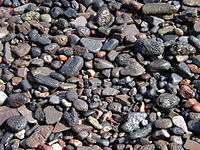
Photo from wikipedia
Biocement as an alternative to cement for soil improvement has been studied for the past decade. A comparative study on the cementation effect on the mechanical behavior of sand by… Click to show full abstract
Biocement as an alternative to cement for soil improvement has been studied for the past decade. A comparative study on the cementation effect on the mechanical behavior of sand by biocement and Portland cement is presented. Drained triaxial tests were carried out on both cement- and biocement-treated sand. The yielding of cemented sand is largely associated with the breakage of bonding. Bonding ratio is defined in this paper to quantify the bonding effect. The bonding provided by biocement is stronger than that by cement, and as a result, the stress ratio at yielding for biocement-treated sand is higher than that for cement-treated sand given the other conditions the same. The shear resistance of cemented sand consists of bonding, dilation and friction. The stress–dilatancy relationship of biocement-treated sand is different from that of cement-treated sand or the Rowe’s stress–dilatancy equation. The increase in stress ratio with dilatancy ratio (1 − δev/δe1) is higher for biocement-treated sand.
Journal Title: Acta Geotechnica
Year Published: 2021
Link to full text (if available)
Share on Social Media: Sign Up to like & get
recommendations!